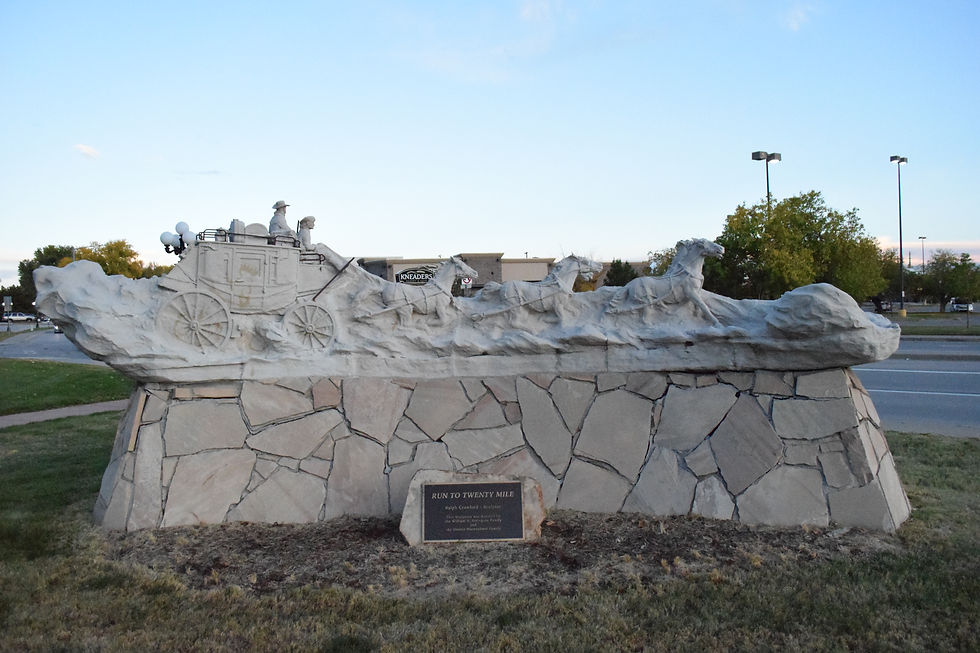20 Mile House Historic Park
- Tess Johnson
- Jan 6
- 4 min read
Tess Johnson - 21 October 2024


It’s embarrassing to think about how long it took me to find this place. Google Maps instructed me to pull into the parking lot for a small shopping center, right off of Main Street in Parker, Colorado. I park in a spot under a streetlamp in a mostly empty lot, as even the sunset begins to fade (yes, I realize I should have gone earlier in the day as I am rapidly losing light). In front of me is an Indian restaurant, to my right is a gated residential community, and to my left is a Jewish school. Where is the 20 Mile House? Did I put in the wrong address?

I got out of my car, and I began to walk on the closest sidewalk. I walked a full half a mile, lapping the shopping center and traveling along Main Street. I stopped at a green space with flags and statues, not quite a park but definitely a dedicated monument. Most of the statues are dedicated to veterans and the military, but there was one large stone sculpture carved to look like a horse-drawn wagon, laden with passengers and cargo. The placard at the base of the sculpture dedicated it to the early travelers to Colorado, recognizing the Cherokee and Smoky Hill Trails. Eventually, after wandering around the intersection and probably looking like a crazy person, I find the 20 Mile House. Nestled between the Main Street intersection and the Jewish school, a small part of the original house was restored and relocated here. And it was small, reminding me of the fancy playhouse my neighbors had growing up. Large yellow and brown stones mark walking paths around the house, each leading to a stone bench a mere 20 yards away. Large signs thank donors and patrons for making this site possible, while the educational signs immediately in front of the house were yellow and peeling, barely legible.

I circled the house several times, gazing inside the darkened windows and scaring a few rabbits with my presence. In all of my wandering, the only other people I saw were in their cars, speeding past to their destinations. At the foot of the entrance was a stone, etched with the names of the Cherokee and Smoky Hill Trail, and acknowledging the role those trails played in the formation of this town. With such an emphasis on the history, why the house was there in the first place, and the desire to integrate that history into the typical infrastructure of the city of Parker, the trail seemed lost. Sure, I was surrounded by city streets, modern trails for modern tools. These streets even seemed to reflect the trails that were here before; most notably Stage Run Road and Twenty Mile Road. But I didn’t find an ideal direction or path in my wandering—there was no dedicated route to direct me like a trail often would. Admittedly, I was underwhelmed by this site. The effort needed to relocate and restore the 20 Mile House felt negated by how isolated and neglected it was. It was difficult to find and confusingly placed. Are people supposed to be able to find and experience this site, or is it simply meant to exist away from the public? I walked back to my car feeling like I had done very little in this place.


Even in my disappointment with 20 Mile House, the experience did push me out of my accepted definition of a trail, and how a trail can continue to exist as into perpetuity. I wanted a dirt path to follow, but I was given a series of streets and historic monuments built on the foundation of that path. Instead of wagon wheel ruts, there were potholes and SUVs. Rather than having an open, flexible space to preserve history, the city of Parker nestled the preserved history among the space that was guided by the trail itself. When considering how trails influence the preservation and telling of human history, I realized that a compromise must be made. That compromise is: should we continue to progress with the flow of history to preserve it, or capture a moment in time in order to do so? Here, history continued to progress and build on the original Smoky Hill Trail, rather than my other experiences which aimed to capture a particular point and attitude in time. Of course, this place may have more visitors when the sky isn’t actively darkening, and that may influence the connection between the history of this place and the local community. It seems like every other business, park, or street is named 20 Mile in this area, which I will admit I never knew had to do with the Smoky Hill Trail and the rest house. Do people who live here know where that name comes from, that a mere 20 miles from Denver west-bound travelers would stop for rest, food, and shelter after facing intense conditions and conflict? Does it matter whether or not people know? The physical monument provides a constant place to refer back to, even if it contrasts with its surroundings.

After this excursion, I have one practicum adventure left before I begin the conclusion of my practicum in my “After” assignment. 20 Mile House stands out like a sore thumb among the other sites, but perhaps I must consider with greater weight because of that. This experience altered my opinion and view of how a trail must be preserved, forcing me to consider the possibility of trails integrating into more modern infrastructure and still existing in their own right. As I prepare to complete the “During” segment of my practicum, I would like to keep in mind this new way of experiencing and defining trails.








Comments